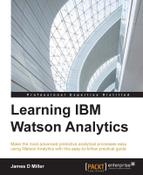In this chapter, we will discuss the Watson Analytics Predict and Assemble functionalities and evaluate a sample use case using these features.
The chapter is organized as follows:
- Predict
- Assemble
- A sample use case
Earlier, we used Watson Analytics Explore to ask questions about several data files and generate interactive visualizations. We used create, filter, and explore to look for patterns and relationships in the data.
In addition to Explore, Watson Analytics also gives us Predict and Assemble. To further analyze a data file, you must create a prediction based on that data. The prediction identifies the data that you are analyzing and includes any insights that are generated from it. Once an insight is identified, you can use the Watson Analytics Assemble capability to express the results of your efforts with Predict and Explore.
Mining of insights—those previously unknown—from your data typically requires complex modeling using sophisticated algorithms to process the data. With Watson Analytics, however, you don't have to know which statistical test to run on your data or even how any of the algorithms actually work.
The method that you use with Watson Analytics is so much simpler; identify/refine your data, create a prediction, and then view the results—that's it!
We have already covered identifying and refining data, so let's now look at predictions and how we can create a prediction.
First, think of predictions as your virtual folders for each predictive analysis effort that you are working on. Here, you identify your data, specify field properties within the data, and select targets and inputs. After you've created the prediction, you can view it to see the output of the analysis. The output consists of visual and text insights.
